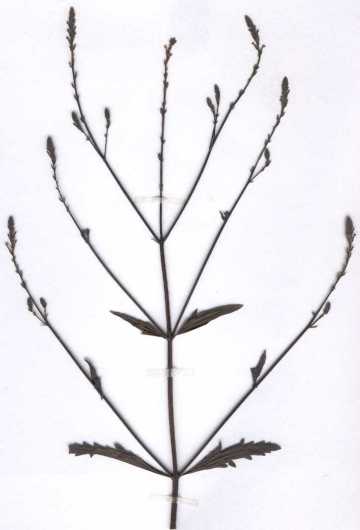
Verbena officinalis (L)
Synonyms and Common names: European vervain, Enchanter's plant, Herb of the Cross, Holy herb, Juno's tears, Pigeon's grass, Pigeonweed, Simpler's joy, Herb of Grace
German = Eisenkraut, French = Verveine, Spanish and Italian = Verbena
Order: Verbenaceae

Description: Verbena is a slender perennial herb, 30-90cm tall, with a woody stalk and several stiffly erect stems. The lower leaves are obovate, deeply divided and stalked, the upper ones lanceolate, slender, sessile and toothed. Tiny blue flowers appear in long slender spikes in the axis of a bract, becoming denser higher up each spike. The fruit comprises four cylindrical nutlets enclosed in the calyx. Verbena is indigenous to England, central and southern Europe, North Africa and Asia, and has been introduced into North America. It grows in waysides and waste places.
Parts used: the aerial parts
Collection: The herb is collected just before the flowers open, usually in July, and dried quickly.
Constituents: Iridoid glycosides (verbenin, verbenalin, bastatoside), bitter principle, tannin, volatile oil (including citral, geraniol, limonene, verbenone), mucilage, unidentified alkaloid, saponin
Actions: Sedative, relaxant, nerve tonic, thymoleptic, spasmolytic, mild diaphoretic, hepatic, reputed galactagogue
Indications: Depression, melancholia, hysteria, generalised seizures, cholecystalgia, jaundice, early stages of fevers. Specifically indicated in depression and the debility of convalescence after fevers, especially influenza.
Therapeutics and Pharmacology: Verbena strengthens the nervous system whilst relaxing tension and stress. It is used in the treatment of depression and melancholia, particularly following a debilitating illness such as influenza. It is used as a relaxant and antispasmodic remedy in asthma, migraine, insomnia and nervous coughing. Verbenalin, one of the constituents, has a direct action on smooth muscle and also has a potential hypotensive effect. As a diaphoretic, the herb is indicated in the early stages of fever.
The glycosides also have a reputed galactagogue and emmenagogue action, and the Chinese use Verbena to treat migraines associated with female sex hormone fluctuations. The galactagogue properties are attributed to aucubin. A luteinising action has been reported, and attributed to inhibition of the gonadotrophic action of the posterior lobe of the pituitary gland. Verbena has been documented to possess weak parasympathetic properties, causing slight contraction of the uterus, and verbenalin exhibits uterine stimulant activity.
Verbena is used on the Continent for liver conditions, jaundice and gallstones, and as a gentle but effective laxative. It is a traditional remedy for infected gums and tooth decay, halitosis and tonsillitis. This is supported by the discovery that the glycoside verbenin has a direct effect on glandular secretions, suggesting an effect on the production of saliva.
A poultice of the herb may be applied to insect bites, sprains and bruises, and the ointment is used to treat eczema, wounds, weeping sores and painful neuralgia.
Combinations: Verbena may be combined with Scutellaria, Cypripedium and Avena in depressive states.
Caution: It should be avoided during pregnancy because it is a uterine stimulant, but it may be taken during labour to stimulate contractions.
Preparation and Dosage: (thrice daily)
Regulatory Status: GSL Schedule 1
Dried herb: 2-4g or by infusion
Liquid Extract: 1:1 in 25% alcohol, 2-4ml
Tincture: 1:1 in 40% alcohol, 5-10ml
Additional Comments: Vervain was one of the sacred herbs of the Druids and was called hiera botane, or sacred plant, by the Romans. Gerard warns against using it for 'witchcraft and sorceries'. It was traditionally believed to be an female aphrodisiac. Until comparatively recently, it was hung round the necks of children to avert infection. It also had a traditional use in the treatment of dropsy; cardioactive glycosides since identified in the plant support this. In China, the plant is known as ma bian cao, and it is used mainly as a fever remedy for malaria and influenza. The Bach flower remedy is indicated in mental stress and over-exertion with insomnia and an inability to relax.
Bibliography
Bartram, T. 1995 Encyclopaedia of Herbal Medicine, 1st edn., Grace Publishers, Bournemouth.
Bremness, L. 1994 Herbs, Dorling Kindersley Eyewitness Handbook, London.
BHMA 1983 British Herbal Pharmacopoeia, BHMA, Bournemouth.
Chevallier, A. 1996 The Encyclopaedia of Medicinal Plants, Dorling Kindersley, London.
Grieve, M. 1931 A Modern Herbal, (ed. C.F. Leyel 1985), London.
Hoffmann, D. 1990 The New Holistic Herbal, Second Edition, Element, Shaftesbury.
Lust, J. 1990 The Herb Book, Bantam, London.
Mabey, R. (ed.) 1991 The Complete New Herbal, Penguin, London.
Mills, S.Y. 1993 The A-Z of Modern Herbalism, Diamond Books, London.
Newall, C.A., Anderson, L.A., & Phillipson, J.D. 1996 Herbal Medicines: A Guide for Health-care Professionals, The Pharmaceutical Press, London.
Ody, P. 1993 The Herb Society's Complete Medicinal Herbal, Dorling Kindersley, London.
Prihoda, A. 1989 The Healing Powers of Nature, Octopus, London.
Vickery, R. 1995 A Dictionary of Plant Lore, Oxford University Press.
Wren, R.C. 1988 Potter's New Cyclopaedia of Botanical Drugs and Preparations, C.W.Daniel, Saffron Walden.










